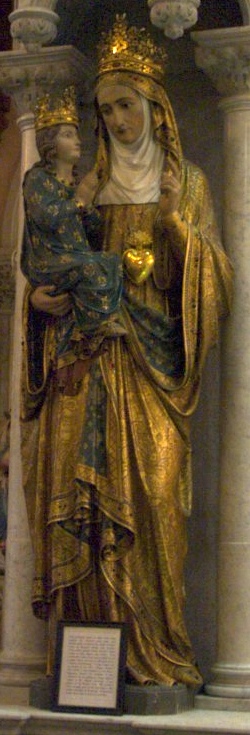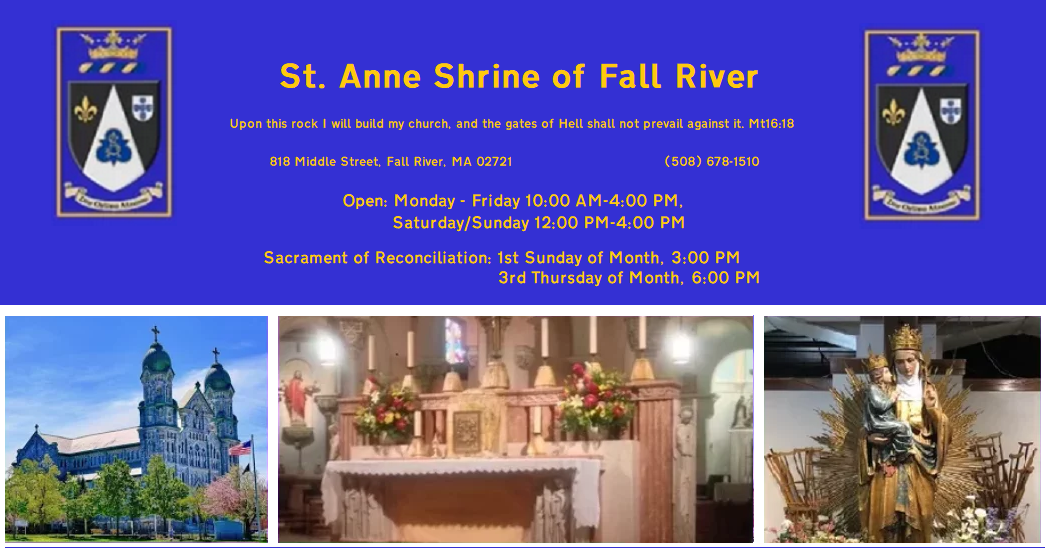The missionary and educational zeal of the Dominicans did not diminish when they climbed up the hill and established themselves on South Main Street. Father Ange-Celestin Cote, OP, the first pastor to be installed in the South Main Street monastery, was also the one with the shortest tenure – less than three months.

Father Cote became the victim of a controversy as to whether Canadian or French Dominicans should direct the parish.
Up to this time, it was the French Dominican refugees who had staffed Saint Anne’s. Following Fr Sauval’s untimely death, two superiors were named: Father Cote as pastor of the parish and Etienne Gauvreau was the new superior of the monastery.
The controversy was settled on 19 August 1901 when Father A. Raymond Grolleau, OP, arrived with official authorization to take possession of both posts: pastor and superior. For the moment, the French Dominicans had won.
Less than six months later, work again resumed on the church with a $225,000 contract with Napoleon Dubuc and Sons with the solemn blessing of the cornerstone on July 14, 1902.
The new pastor formed the Saint Dominic Association and then turned to the missionary and educational zeal that was a trademark of the Fathers. A parish library was organized; plans were being envisioned for a Catholic hospital.
In April 1904, Father Grolleau went to Europe and secured the services of the Dominican Sisters of the Presentation. Construction for a hospital adjacent to the parish church began in the autumn.
To help with the financing of the building of the basilica parish church, a two-year series of plays and comedies and musicals was begun.
1905 built on the previous years: the statues of the Good Shepherd and Saint Anne were blessed on July 7. These statues would be central parts of the great façade of the church on South Main Street. The Third Order of Saint Dominic was also formed to assure a Dominican apostolate in the parish. In September, the great copper statue of Saint Anne was finished. It would reign from the pinnacle of the hospital on Middle Street.
A truly historic year for Fall River was 1906. On 4 February, Saint Anne Hospital was blessed and dedicated; on 4 July, the great parish church was blessed and dedicated.
The present monastery on Middle Street was blessed in 1907 and the old South Main Street monastery was destined to become the parish commercial college.
Another very eventful year was 1908. The North American Congregation of Saint Dominic was formed. Fall River would henceforth no longer depend on France but on the Dominicans of Canada. The first result was a painful one: Father Grolleau, a Frenchman, resigned as pastor on 7 May 1909.
Again the designation of two superiors came into being: Father Ange-Emile Dion, OP, became the pastor and Father Pie Marie Beliveau was the monastery’s superior. Soon the Fall River mission would be upgraded when, on 7 June 1910, the Middle Street monastery became a priory.
Parish societies were formed by Father Dion: Saint Vincent de Paul Society (1910); the Lacordaires and the Jeanne d’Arc anti-alcoholic societies (1911); the Semaine Paroissiales, a newspaper that would serve the parish and the area French-speaking parishes; the Confraternity of the Infant Jesus (1915).
1919 would be the parish’s Golden Jubilee and Dominican zeal would again be especially witnessed: a $100,000 drive was launched to build a great school that would centralize and house the parish’s many schools from the south end, the Plymouth Avenue East, and the Maplewood area.
At the end of the year, Father Dion was named pastor of Notre Dame de Grace Parish in Montreal. Father Pierre Granger, OP became pastor.
Father Granger’s dreams of a great school would be shockingly set back. On 13 May 1920, the lower church — what is today designated the “shrine” — was destroyed by fire. It would take over a year of time and expense to restore the lower church. Barely was the cornerstone of the new school blessed in October 1923 that Father Granger was transferred on 7 August 1924.
The new pastor was Father Mannes Marion, O.P. Times were difficult and getting worse economically throughout the nation but especially difficult in a city of mills.
The new pastor’s work would have to be to get the parish set for the Depression. The poor had to be tended to. Most of Father Marion’s work with the physical plant would be house-cleaning: the Hunter Street rectory was razed (1926), as was the one on South Main Street (1931), together with houses between the church and Park Street. This especially brought out the beauty of the great church since nothing stood in the way of the great marble masterpiece.
A great celebration occurred during the pastorate of Father Marion: on 13 September 1925, Saint Anne School was solemnly blessed.
In 1938, Father Marion retired and the first Franco-American became pastor: Father Dominique Beaulne, O.P., a Wisconsonian. Most of this dedicated priest’s apostolate had to do with the poor and helping the parish survive the Depression. It was a difficult time and not one for new enterprises.
He was succeeded by another Franco-American, Father Thomas M. Landry, O.P., a New Bedford native. Twice he would serve as pastor of Saint Anne and both times he would be savior to the parish, raising it from heavy burdens of great debts.
Father Landry’s first pastorate was marked with the rebuilding of the church roof that had been damaged by previous hurricanes, and the celebration of the great Diamond Jubilee of the parish.
In 1957, Father Landry would return to other apostolates in Canada and a military man would succeed him: Father Henri Laporte, O.P.
For the seven years of his apostolate, it was the renewal of the church that was stressed. The entire interior of the church would be redone with polished marble replacing white-painted wood. Special stained-glass windows would be imported from Europe and a great organ would give life to all the liturgically-correct interior.
Father Raymond Drouin, OP, succeeded Father Laporte in 1964. The parish was again struggling under heavy debt. He founded the Council of Catholic Women and the providential Parish Committee in 1967. During his pastorate the parish celebrated its historic centennial.
On 25 October 1971, Father Landry returned to Saint Anne’s again as pastor. A school crisis began to be sensed with increasing expenses, fewer students and even fewer Religious teachers. Father Landry found economic measures to strengthen its apostolate and gradually repay past debts. A Parish Board of Education was formed in 1974 to assure religious education of the parish’s youth even if the school should have to be closed. A Parish Religious Education Coordinator was hired.
On 1 February 1975, Father R. Gabriel Blain, OP, was named as the new pastor. His quiet insistence on prayerful dedication, all the while claiming no administrative experience, brought about a great spiritual renewal in the parish and practically wiped out the heavy debt.
A Parish Liturgy Committee gave direction; the New Prayer Life Charismatic Group was formed, as was a rich Retreat and Recollection movement. A Youth Fellowship, attracting youths from other parishes even, stressed the prayer, discipline, and hope the day’s youth had to face. Saint Patrick’s Parish in Somerset was a great aid to the pastor in establishing many youth apostolates.
On 4 January 1978, Father Blain resigned as pastor of Saint Anne Parish. The Dominican Province of Canada had decided that it would gradually pull out of parish work and insist instead on educational endeavors. The Dominicans would cease to operate Saint Anne Parish. Ninety years of exemplary devotion and missionary zeal had been offered to God and the Canadian immigrant; ninety years of priestly service had graced the City of Fall River.
